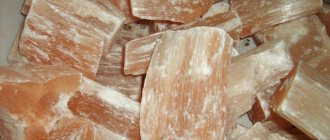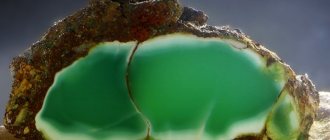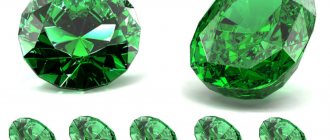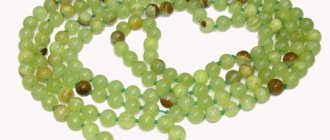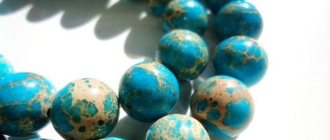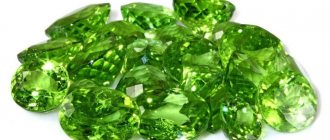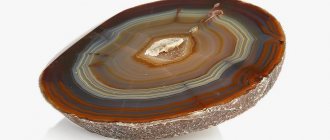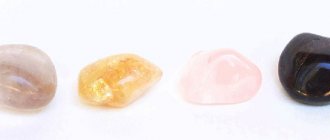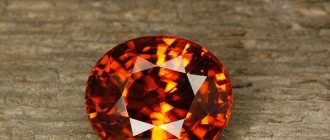This amazing stone is compared in its appearance to young unfermented wine, to the sun in a bottle, to Chartreuse liqueur.
Prehnite stone is surrounded by controversy - it is quite common in nature, but is rarely used in jewelry.
Prehnite belongs to the third group of stones, but products with it are quite expensive. This is the first mineral to be named after the person who discovered it.
Prehnite stone is often confused with peridot and chrysoberyl . It has many other names - Cape emerald, grape jade, edelite, adilite, chiltonite.
Origin story
In the mid-18th century, the Danish navigator and explorer Hendrik von Prehn brought to Europe an unknown stone that he found at the Cape of Good Hope.
Jewelers of that time liked the new stone, and they began to include the mineral in their compositions; it soon became fashionable and was called “prehnite.”
At that time, a recipe for Chartreuse liqueur was invented, and the color of prehnite was compared with the color of the popular liqueur.
Gradually, the stone was forgotten and only in the 70s of the last century, when a new deposit of high-quality prehnite was found in Australia, did it become popular again. The color and size of a stone are criteria for its value.
Where is it mined?
Prehnite is a mineral that gained late fame. It was used before, but not everyone was allowed to do so. In the middle of the 18th century, the stone received the status of precious, and the counters were overflowing with jewelry with green gems.
After Africa, deposits were discovered in other places:
- America;
- China;
- Italy;
- Scotland;
- France;
- India;
- Kazakhstan;
- Russia.
Some of the best samples come from Australia and New Zealand. The minerals that come from there have yellow-golden hues. But prehnite from the USA is very similar to emerald; without special equipment, it can be difficult even for a specialist to understand which stone is which.
Physical properties
- In nature, prehnite occurs in a spherical form; its clusters resemble clusters of unripe grapes.
- Prehnite consists mainly of luminosilicate, calcium and magnesium.
- Chemical formula: Ca2Al(Al, Si3O10)(OH)2.
- Its hardness on the Mohs scale is 6-6.5 units. Prehnite lends itself well to cutting.
- The specific gravity of prehnite is 2.9 units.
- Prehnite does not tolerate high temperatures and begins to melt in fire. It can be destroyed by hydrochloric acid.
Prehnite deposits
In nature, this mineral, a silicate, is quite common. Most often it is found in the form of a small cluster of milky green balls, reminiscent of a bunch of grapes. Because of this similarity, it is called grape jade in some Asian countries. In South Africa it is known as the Cape emerald.
Prehnite deposits are found in Australia, China, Germany, France and Austria. It is also found in the Urals, where it is valued as an ornamental stone, in the Krasnoyarsk Territory, Central Asia and Kazakhstan.
Varieties, shades
When processed, the stone has a glassy or pearlescent sheen.
In terms of its transparency, the mineral can be translucent, translucent and completely transparent. Transparent stones are rare and are more valuable. Prehnite is capable of producing a glow in any light.
Natural prehnite has a variety of shades:
- light green;
- whitish;
- grayish green;
- yellowish brown;
- yellowish green.
It should be noted that the color of prehnite is often heterogeneous; sometimes one can observe inclusions of rutile needles and various spots in the thickness of the mineral.
Australian prehnite is especially beautiful and valuable; when processed, it emits a special light coming from within, similar to the glow of a moonstone. The Malian prehnite is not inferior to it in beauty.
How to spot a fake
Counterfeits on jewelry counters are not at all uncommon. So it is necessary to check not only rare expensive minerals, but also semi-precious stones.
How to do it:
- real prehnite has a somewhat muted color;
- he warms up from the warmth of his hands, but he needs time to take the heat to himself;
- There are inclusions inside any mineral - in prehnite these are bubbles;
- fakes are usually lighter in weight than natural stones.
The shape of a mineral cannot be ideal, because it was created by nature, and not by the hands of a scientist.
Chrombonite is sometimes sold under the guise of prehnite. This synthetic green alternative was created in a laboratory to replace emerald. Later it was used as an imitation of prehnite.
It’s great if you have the opportunity to compare impressions with a previously purchased stone of natural origin. But what to do if there is no such experience? It would be better to ask a friend who knows about stones for help. Or borrow samples from someone to do an at-home test.
Magic properties
Even in ancient times, it was noticed that prehnite has certain magical properties. If a person has some clairvoyant abilities, then wearing prehnite greatly enhances them.
The stone can cause prophetic dreams, helps to see deceased relatives in a dream and talk to them.
The stone helped African and Australian shamans interact with spirits. The most valuable in this regard was transparent prehnite interspersed with rutile needles.
Prehnite is especially useful for women; it gives them confidence, feminine attractiveness, helps them achieve family happiness, and helps them overcome difficulties in love relationships.
The stone is recommended to be worn by people with a strong psyche; it can cause harm to unbalanced people. And it’s better not to wear it all the time, but for several hours a day.
Questions/Answers
We will be glad to receive your questions. Asking questions means you are a thinking and caring person
